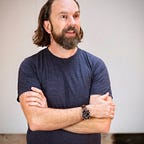Interview with Farrah Bostic
In advance of the Leading Design conference in London on the 24th-26th October, I caught up with Farrah Bostic to discuss her background, experience and thoughts on the subject of Design Leadership.
Tell us about your first design leadership role? Who did you model yourself on?
My very first design leadership role was in a web design startup in Los Angeles in 1999. I was the creative director. I had no models, no role models, no idea what I was doing. I read everything I could get my hands or eyes on, I listened to other people, I failed, a lot. And I also made some pretty cool shit.
What does a typical day look like for you? Is it all meetings?
Since I work for myself, a typical day doesn’t exist. I toggle between meetings in person, via skype or conference call; multiple slack channels/teams for various projects; email email email; trying to keep up with all the reading I have to do both as a strategist and researcher, but also as a member of the part time faculty at Parsons School of Design at The New School. And then there is fieldwork, where I’m fairly cut off from everything except the people I’m observing and interviewing. In my spare time, I walk my dog.
Do you still get to do any “real” design?
I’m not, strictly speaking, a designer — but I do real design thinking work, and real design research. As a consultant, it’s really hard to farm it out (clients want me to do the work), and as a practitioner, it’s hard to develop the empathy I need to do my job when I stay too far at arm’s length. But I can’t be everywhere, so there’s a lot of load balancing that has to be done.
What are the qualities of a good design leader?
Empathy for others, self-awareness, a willingness to experiment, be wrong and a desire to improve, open ears and eyes and hearts, the confidence to place your bets and the humility to admit you’ve lost, an insatiable curiosity, a sense of loyalty to your users first, your team second, and your product or brand third, a drive to always be learning, leveling up, gaining expertise and then a similar drive to dive into topics and experiences in which you are an absolute novice, an ability to choose well between solitary thinking work and richly collaborative work. A general aversion to meetings for their own sake. An innate sense of priorities, an understanding of what is urgent, important, or neither.
What is the design culture like in your current company?
I work, more or less, in two organizations. One is my own consultancy, in which I work with a network of other researchers, strategists and designers or developers, as well as closely with my clients’ product and brand teams, and their senior leadership teams or boards. The other is Parsons, where I work with other faculty, and with my students. The culture tends to shift with the people. But I try to bring some core values to each layer of each engagement: a bias to action, and an embrace of radical collaboration, user-centrism and interdisciplinary teams and roles. They take on different shades and modes in each team, but they remain my personal constants.
What challenges are you facing at the moment and what are you doing to overcome them?
I’m not sure there’s enough room on the page to list them all… I’m trying to develop a community of peers around the subject of design research, an area that is often underutilized and underfunded. I’m trying to create systems that allow my clients to tap into a network of researchers and recruiters that can scale up or down to any given initiative or need. I’m trying to teach design research to my clients so they don’t have to outsource empathy to people like me. I’m trying to design my next semester’s class so my master’s students can walk away as highly skilled design leaders.
How is your design team structured and how is that working? Anything you’d tweak?
i’m not sure my way of working really fits this question
What are you most proud of achieving as a design leader?
There are two kinds of achievements that I am most proud of — changing the organization, and changing the product. I’ve helped clients bring design thinking and design research into their own practices and taught their teams how to level up their overall design process with these tools. I’ve helped clients make decisions about culture and process that improve the end product more than any incremental product design work. I’ve helped clients discover genuinely new products and services that deliver value to the business and to their customers. Any time I’ve helped foment transformation, I’m proud of that.
Any advice for a new design leader?
Leading starts with listening. Do that first, and all the time. Then apply your point of view. Be confident in your decisions, while still remaining open to the possibility you will be wrong.
Anything else on your mind at the moment?
Structural constraints. We’re constantly asking users to do things — we’re asking our teams to do things — that they actually can’t do (or can’t do successfully) under the current conditions. Sometimes there are good reasons for those constraints (safety or other needed regulations, for example), and sometimes there are bad reasons for those constraints (tradition or special interests or bad design, usually). Sometimes we need to design around these obstacles, or through them; sometimes we have to design for them. Getting people to acknowledge these constraints, take some responsibility for them, reckon with them, and make decisions that are mindful of them — that’s what’s on my mind these days.
